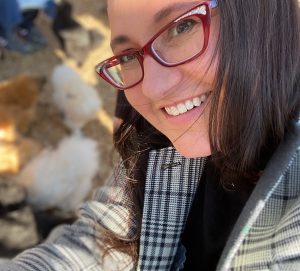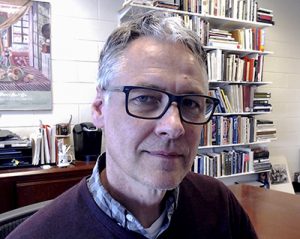CAA News Today
CAA 2021 Artists’ Interviews: Polly Apfelbaum interviewed by David Pagel
posted by Allison Walters — December 11, 2020
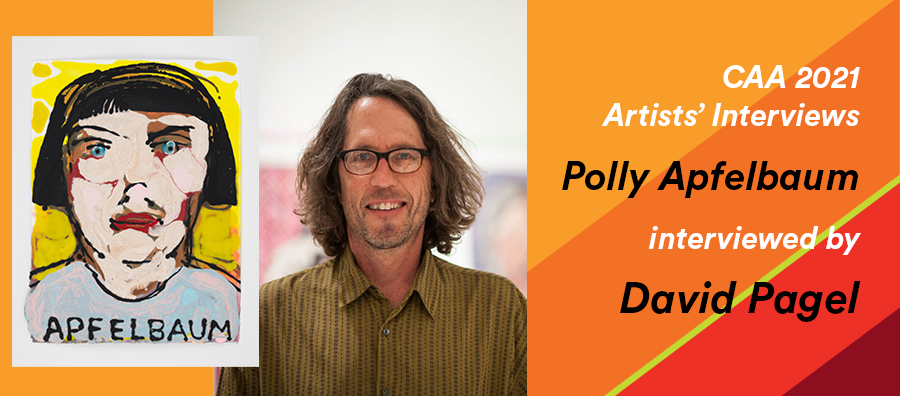
Polly Apfelbaum, image credit: Nicole Eisenman, Apfelbaum, 2019, Paper pulp drawing, Paper dimensions: 30 1/2 x 22 1/2 in, Courtesy the artist and Anton Kern Gallery.
David Pagel.
We are excited to announce that one of this year’s Artists’ Interviews will feature Polly Apfelbaum, interviewed by David Pagel.
Beginning in 1997, the Annual Artists’ Interviews were established to provide the opportunity for esteemed artists to have one-on-one conversations with colleagues at the Annual Conference.
Each year, the Services to Artists Committee identifies two distinguished artists to participate. The interviews, held as part of the Services to Artists Program, provide a unique opportunity for members to hear insights from artists in dialogue with the interviewer. Access to this program content requires free registration for “Free and Open Sessions” and is included in paid registration. This year’s Artists’ Interviews are supported by a generous grant from the NEA.
Speaker Biographies
New York-based artist Polly Apfelbaum’s (b.1955) work has situated itself as a hybrid of painting, sculpture, and installation over a career spanning 30-plus years. Exploring the intricacies of color, Apfelbaum weaves her way, both literally and conceptually, through ideas of Minimalism, Pop aesthetics, and Color Field painting to blur the lines between two-and three-dimensional art making. Apfelbaum graduated from the Tyler School of Art, Elkins Park, Pennsylvania. She has exhibited consistently since her first solo show in 1986. Her work has recently been recognized with a Pew Center for Arts Grant, a Creative Capital Award, and the 2012 Rome Prize at the American Academy. She has also received a Joan Mitchell Grant, The Diebenkorn Fellowship, a Pollock-Krasner Foundation Grant, an Anonymous Was a Woman Grant, and a Guggenheim Fellowship.
Recent solo exhibitions include: “Waiting For the UFO’s (a space between a landscape and a bunch of flowers)” at the Kemper Museum, Kansas City, and the Ikon Gallery, Birmingham, UK (2019); “Haystack Hands” at Haystack Mountain School of Craft, Deer Isle, ME; “Happiness Runs” at Belvedere 21, in Vienna, Austria (2018); “Dubuffet’s Feet, My Hands” at Frith Gallery, London, UK (2017); “The Potential of Women” at Alexander Gray Associates, New York, NY (2017); “Face (Geometry)(Naked) Eyes,” Otis College of Art and Design, Los Angeles, CA (2016); and “Deep Purple, Red Shoes,” Be-Part, Waregem, Belgium (2015). She is represented in numerous collections including: Brooklyn Museum of Art, Brooklyn, NY; Carnegie Museum of Art, Pittsburgh, PA; Dallas Museum of Art, Dallas, TX; Los Angeles County Museum of Art, Los Angeles, CA; Museum of Modern Art, New York, NY; Philadelphia Museum of Art, Philadelphia, PA; Whitney Museum of American Art, New York, NY.
David Pagel is an art critic who lives in Los Angeles and regularly contributes to the Los Angeles Times. He is a professor of art theory and history at Claremont Graduate University and an adjunct curator at the Parrish Art Museum in Water Mill, NY, where he has organized “Telling Stories: Changing the Narratives” (2020) and “Unfinished Business: Paintings from the 1970s and 1980s by Ross Bleckner, Eric Fischl and David Salle” (2016).
Recent publications include “Jim Shaw” (Lund Humphries, 2019) and “Talking Beauty: A Conversation Between Joseph Raffael and David Pagel About Art, Love, Death, and Creativity” (Zero+, 2019). An avid cyclist, he is a seven-time winner of the California Triple Crown.
Apfelbaum and Pagel’s pre-recorded conversation will be available starting on February 5, 2021. They will host a live online Q&A on Friday, February 12 at 5:30pm EST.
Apply to Join the CAA Council of Readers
posted by Allison Walters — December 10, 2020
In preparation for the spring submission cycle for the 2022 Annual Conference, the Annual Conference Committee will appoint up to 22 new members to the Council of Readers. Council members read and rate session and presentation proposals and serve a crucial role in the review process for the Annual Conference.
Over 950 proposals are submitted for review each year for selection to the conference program. Each proposal is read by three Council members. By providing their time, knowledge, and expertise of their fields, the council helps to shape the conference program. Each member of the Council reviews up to 60 proposals per year from across CAA’s fields of study and as much as possible from within their self-identified scholarly focus and knowledge. Most proposals include one 250-word abstract, while complete session submissions can include 4-5 abstracts (1250 words). Each reader receives a similar amount of content.
Requirements for Readers
- Current CAA membership
- Time commitment to read and review no more than 60 proposals online in May-June 2021
- Ability to participate as a Council of Readers member for up to three years
- Readers are required to read and abide by CAA’s Statement on Conflict of Interest and Confidentiality
- Abbreviated CV uploaded to online form
- Completed online form
Application deadline: February 25, 2021
More details:
- The Council of Readers is a group of 50 to 75 CAA members from Professional Committees, Affiliated Societies, and general membership overseen by the Annual Conference chair.
- Readers will be asked to review proposals from across CAA’s fields of study, and as much as possible from within their self-identified scholarly focus. Readers with broad areas of interest are encouraged to participate.
- The proposals will be distributed in early May and must be completed by mid June.
- Readers will access abstracts and complete their reviews in our online system, with orientation and support from the Annual Conference Committee and CAA staff members.
- Each proposal is read and reviewed in the online portal by three different Council members.
- The majority of proposals include a single 250-word abstract, while complete session submissions can include 4-5 abstracts (1250 words).
- Readers will review no more than 60 proposals each, with proportional share of abstracts.
- For each proposal, Readers will use a scale of 1-5 to answer five questions and also enter a short comment for the Annual Conference Committee’s review.
- Members of the Council of Readers serve a three-year term on a rotation so that each year, one third of the council is new.
- The Council of Readers does not meet together in person or electronically.
- After proposals are read and reviewed by the Council, the chair reports to the Annual Conference Committee on session topics, including identifying possible areas of content that are missing from the submissions received.
- The chair finalizes the conference content based on the reviewed submissions.
Please email programs@collegeart.org with any questions.
CAA 2021 Artists’ Interviews: Alan Michelson interviewed by David Joselit
posted by Allison Walters — December 07, 2020
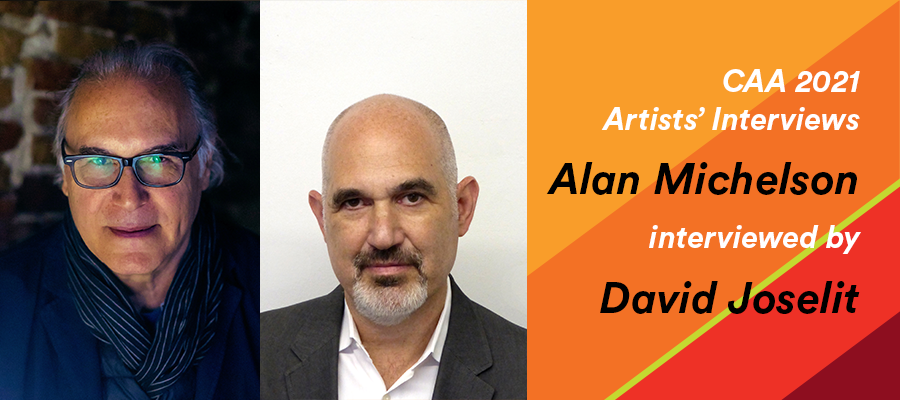
Alan Michelson, photo: Karolina Sobel. David Joselit, photo: Mary Ellen Carroll.
We are pleased to announce that one of this year’s Artists’ Interviews will feature Alan Michelson, interviewed by David Joselit.
Beginning in 1997, the Annual Artists’ Interviews were established to provide the opportunity for esteemed artists to have one-on-one conversations with colleagues at the Annual Conference.
Each year, the Services to Artists Committee identifies two distinguished artists to participate. The interviews, held as part of the Services to Artists Program, provide a unique opportunity for members to hear insights from artists in dialogue with the interviewer. Access to this program content requires free registration for “Free and Open Sessions” and is included in paid registration. This year’s Artists’ Interviews are supported by a generous grant from the NEA.
Speaker Biographies
Alan Michelson is an internationally recognized New York-based artist, curator, writer, lecturer and Mohawk member of the Six Nations of the Grand River.
For over thirty years, he has been a leading practitioner of a socially engaged, critically aware, site-specific art grounded in local context and informed by the retrieval of repressed histories. Recent exhibitions include Alan Michelson: Wolf Nation, Whitney Museum of American Art, Volume 0, Zuecca Projects, Venice, and Citizenship: A Practice of Society, MCA Denver.
His work is in the permanent collections of the Whitney Museum of American Art, the National Gallery of Canada, the Smithsonian National Museum of the American Indian, and the Art Gallery of Ontario. His essays have recently appeared in Frieze and October.
Public art is also part of his diverse practice, and Mantle, his large-scale monument honoring Virginia’s Indian nations was dedicated at the capitol in Richmond in 2018.
Michelson is co-founder and co-curator, with the Vera List Center for Art and Politics at the New School, of the groundbreaking Indigenous New York series.
David Joselit is Professor of Art, Film, and Visual Studies at Harvard. Joselit is author of Infinite Regress: Marcel Duchamp 1910-1941 (MIT, 1998), American Art Since 1945 (Thames and Hudson, 2003), Feedback: Television Against Democracy (MIT, 2007), and After Art (Princeton University Press, 2012). He co-organized the exhibition, “Painting 2.0: Expression in the Information Age,” which opened at the Brandhorst Museum in Munich in 2015.
Joselit is an editor of the journal OCTOBER and writes regularly on contemporary art and culture. His most recent book is Heritage and Debt: Art in Globalization (MIT Press 2020).
Michelson and Joselit’s pre-recorded conversation will be available starting on February 5, 2021. They will host a live online Q&A on Friday, February 12 at 4:30 pm EST.
Notice of CAA 109th Annual Business Meeting
posted by Allison Walters — December 04, 2020
College Art Association
Notice of 109th Annual Business Meeting
Friday, February 12, 2021
2:00 p.m. EST
The 109th Annual Business Meeting of the members of the College Art Association will be called to order at 2:00 p.m. EST on Friday, February 12th at the 2021 Annual Conference. Access to this meeting requires free registration for “Free and Open Sessions” and is included in paid registration. Once you have registered, please log into the online conference portal to attend the meeting.
CAA President, N. Elizabeth Schlatter will preside.
AGENDA
- Welcome / Call to Order – N. Elizabeth Schlatter, CAA President
- Executive Director’s Report – Meme Omogbai
- Approval of Minutes of 108th Annual Business Meeting, held in two parts, February 12 and February 14, 2020 [ACTION ITEM] See CAA 108th Annual Business Meeting Minutes.
- Financial Report: Robert Tofolo, Chief Financial Officer
- Old Business
- New Business
- Results of Election of New Directors – N. Elizabeth Schlatter, CAA President
- Adjournment
Proxies
If you are unable to attend the Annual Business Meeting, kindly complete a proxy online to appoint the individuals named thereon to (i) vote, as directed by you, for directors, and, at their discretion, on such other matters as may properly come before the Annual Business Meeting; and (ii) vote on any and all adjournments thereof. CAA Members will be notified when the proxy for casting votes becomes available — online in late December 2020. A proxy, with your vote for directors, must be received no later than 6:00 p.m. EST Thursday, February 11th, 2021.
Next Meeting – 2022
The 110th Annual Business Meeting of the College Art Association will be held in Chicago in 2022, precise date to be announced.
Colin Blakely, Secretary
College Art Association
December 10, 2020
CAA 108th Annual Business Meeting Minutes
posted by Allison Walters — December 04, 2020
College Art Association
108th Annual Business Meeting
MINUTES
Hilton Chicago, 720 South Michigan Avenue, Chicago, IL
Part I: February 12, 2020: Convocation, 6:00PM, Grand Ballroom
Part II: February 14, 2020: 2:00PM, Room 4A
Part I: February 12, 2020
I. Welcome
David Raizman, Interim Executive Director, welcomed attendees to the Convocation and to the Association’s 108th Annual Business Meeting.
II. Executive Director’s report
Raizman noted that this year’s Annual Conference has approximately 375 ninety-minute sessions.
This year, in collaboration with the Committee on Women in the Arts, the conference offers a selection of sessions, papers, speakers, and related programming in celebration of the Centennial of Women’s Suffrage in the US. Approximately 50% of the conference’s content is focused on women-centered research, artistic presentations, and discourse. Also, as of this year, the conference program is available only in a variety of digital formats, including the conference app and a downloadable pdf file.
President Jim Hopfensperger was not in attendance, and President-Elect N. Elizabeth Schlatter was ill and could not attend the conference.
III. Awards for Achievement
The awards for achievement were presented by former Presidents: Suzanne Blier, DeWitt Godfrey, Anne Goodyear. The 2020 Professional Development Fellowships in Art History and Visual Art were presented by Raizman.
IV. Keynote address
Raizman introduced Amanda Williams, visual artist and architect, who presented the keynote address.
Part II: February 14, 2020
V. Call to Order
Raizman called the meeting to order.
VI. Approval of Minutes
Raizman asked for a motion to approve the minutes of the meeting held on February 13 and 15, 2019. Cunard made the motion, seconded by Blakely. Motion was approved.
VII. Financial Report
Robert Tofolo, Chief Financial Officer, presented the financial report for the Association for the year ending June 30, 2019. The Association posted an operating deficit of $-167,000, versus a forecasted deficit of $-189,000 and against it original budget of $57,000. The Association continues to work to budget expenses within projected revenue targets. Revenue totaled $3,523,000 against expenses of $3,690,000.
As of June 30, 2019, there were 7,773 (8,435, -8%) individual members. There were 464 (461) organizational members and an additional 617 (651, -5%) subscribers to The Art Bulletin and/or Art Journal through the Association’s co-publisher Taylor and Francis.
The market value of the investment portfolio as of June 30, 2019 was $9,609,945 versus the prior year balance of $9,514,314.
Copies of the audited financial statements for fiscal year 2019 are available and they will be posted as a PDF on the Association’s website.
The Executive Director search is ongoing, conducted by the search committee comprising Directors and staff members.
The number of attendees at this Annual Conference stands at 3,300 as of this afternoon.
VIII. Election of Board Members
Julia Sienkewicz, Vice President for Committees, presented the results of the elections of new members to the Board. The following four members were elected to the Board by the membership to serve a four-year term starting in May 2020:
- Mora Beauchamp-Byrd
- Scherezade Garcia-Vazquez
- Tiffany Holmes
- Nada Shabout
The following member was elected to the Board as an Emerging Professional Director to serve a two-year term starting in May 2020:
- Lara Ayad
IX. Old Business
Raizman called for old business. There was none.
X. New Business
Raizman called for new business. There was none.
XI. Adjournment
Raizman adjourned the meeting.
Vote for CAA’s 2021 Board of Directors
posted by Allison Walters — December 03, 2020
As a CAA member, voting is one of the best ways to shape the future of your professional organization. Thank you for taking the time to vote! Scroll down to meet this year’s candidates and submit your online voting form.
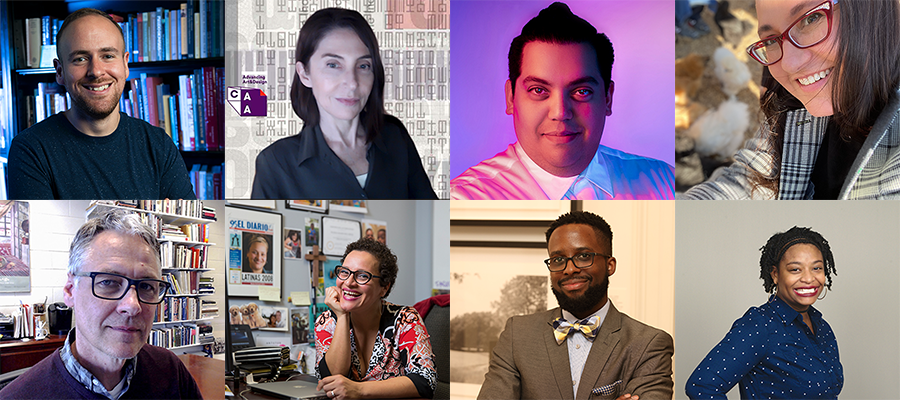
2021 CAA Board of Directors candidates, from left to right, top to bottom: Roland Betancourt, Patricia Childers, Alberto De Salvatierra, Lara Evans, Charles Kanwischer, Wanda Raimundi-Ortiz, Kelvin Parnell, and Kelly Walters.
2021 CAA BOARD OF DIRECTORS ELECTION
The CAA Board of Directors is comprised of professionals in the visual arts who are elected annually by the membership to serve four-year terms (or, in the case of the Emerging Professional Board members, two-year terms). The Board is charged with CAA’s long-term financial stability and strategic direction; it is also the Association’s governing body. The board sets policy regarding all aspects of CAA’s activities, including publishing, the Annual Conference, awards and fellowships, advocacy, and committee procedures. For more information, please read the CAA By-laws on Nominations, Elections, and Appointments.
MEET THE CANDIDATES
The 2020–21 Nominating Committee has selected the following candidates for election to the CAA Board of Directors. Click the names of the candidates below to read their statements and resumes before casting your vote.
BOARD OF DIRECTOR CANDIDATES (FOUR-YEAR TERM, 2021-2025)
Roland Betancourt, Professor of Art History, University of California Irvine, Irvine, CA
 Alberto De Salvatierra, Assistant Professor of Urbanism and Data in Architecture + Director of the Center for Civilization, University of Calgary School of Architecture, Planning and Landscape (SAPL), Calgary, Alberta, Canada
Alberto De Salvatierra, Assistant Professor of Urbanism and Data in Architecture + Director of the Center for Civilization, University of Calgary School of Architecture, Planning and Landscape (SAPL), Calgary, Alberta, Canada
Lara Evans, Interim Director, Research Center for Contemporary Native Arts, Institute of American Indian Arts, Santa Fe, NM
Charles Kanwischer, Director, School of Art, Bowling Green State University, Bowling Green, OH
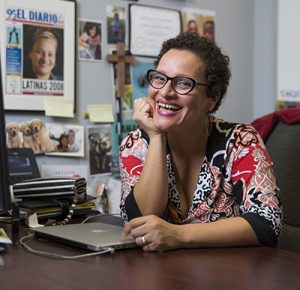 Wanda Raimundi-Ortiz, Associate Professor, Studio Art, University of Central Florida, Orlando, FL
Wanda Raimundi-Ortiz, Associate Professor, Studio Art, University of Central Florida, Orlando, FL
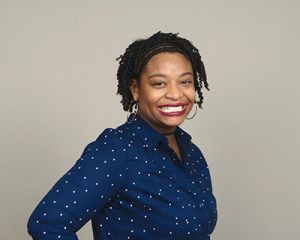 Kelly Walters, Associate Director, BFA Communication Design Program, Parsons School of Design, The New School, New York, NY
Kelly Walters, Associate Director, BFA Communication Design Program, Parsons School of Design, The New School, New York, NY
Emerging Professionals BOARD OF DIRECTOR CANDIDATES (TWO-YEAR TERM, 2021-2023)

Patricia Childers, Adjunct Faculty, New York City College of Technology, City University of New York (CUNY), Communication Design Department, New York, NY
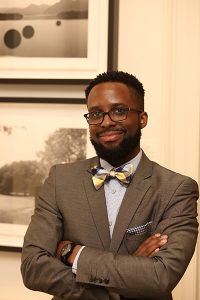
Kelvin Parnell, Ph.D. Candidate, Art and Architectural History, University of Virginia, Charlottesville, VA
CAA members must cast their votes for board members online using the link below; no paper ballots will be mailed. The deadline for voting is 6:00 p.m. EST on February 11, 2021.
The elected individuals will be announced at CAA’s Annual Business Meeting to be held at 2:00 p.m. on Friday, February 12, 2021.
Questions? Contact Vanessa Jalet, executive liaison, at (212) 392-4434 or vjalet@collegeart.org
CAA Table Talk, November 18, 2020
posted by Allison Walters — November 24, 2020
We’re delighted to introduce CAA members to a new series of conversations between Meme Omogbai, our executive director and CEO, and N. Elizabeth Schlatter, the president of the CAA Board of Directors. Amidst so much change in our lives, workplaces, and world, CAA leadership sat down for an informal chat on how CAA is reshaping its efforts to provide access and resources where members need it most. Meme and Elizabeth will speak on the economic implications of COVID-19, the urgent importance of members’ scholarship, and the changing terrain of this cultural moment.
This discussion is centered around the Annual Conference and CAA’s pivot towards a digital-first platform, inspired by many of the questions submitted by members.
We would love to hear your questions for future CAA Table Talk conversations. Please send them in advance to: caanews@collegeart.org
SPEAKER BIOGRAPHIES
Meme Omogbai is Executive Director and CEO of College Art Association (CAA). Before joining CAA, Omogbai served as a member and past Board Chair of the New Jersey Historic Trust, one of four landmark entities dedicated to preservation of the state’s historic and cultural heritage and Montclair State University’s Advisory Board. Named one of 25 Influential Black Women in Business by The Network Journal, Meme has over 25 years of experience in corporate, government, higher education, and museum sectors. As the first American of African descent to chair the American Alliance of Museums, Omogbai led an initiative to rebrand the AAM as a global, inclusive alliance. While COO and Trustee, she spearheaded a major transformation in operating performance at the Newark Museum. During her time as Deputy Assistant Chancellor of New Jersey’s Department of Higher Education, Omogbai received Legislative acknowledgement and was recognized with the New Jersey Meritorious Service Award for her work on college affordability initiatives for families. Omogbai received her MBA from Rutgers University and holds a CPA. She did post-graduate work at Harvard University’s Executive Management Program and has earned the designation of Chartered Global Management Accountant. She studied global museum executive leadership at the J. Paul Getty Trust Museum Leadership Institute, where she also served on the faculty.
Elizabeth Schlatter is the President of the CAA Board of Directors and Deputy Director and Curator of Exhibitions at the University of Richmond Museums, Virginia. A museum administrator, curator, and writer, she focuses on modern and contemporary art and on topics related to curating and issues specific to university museums. At UR, she has curated more than 20 exhibitions, including recent group exhibitions of contemporary art such as “Crooked Data: (Mis)Information in Contemporary Art,” “Anti-Grand: Contemporary Perspectives on Landscape,” and “Art=Text=Art: Works by Contemporary Artists.” She also serves on and chairs various University and School of Arts & Sciences committees. Prior to the University of Richmond, she worked with exhibitions at the Smithsonian Institution Traveling Exhibition Service (SITES) in Washington, D.C, and in fundraising at the Contemporary Arts Museum, Houston. She is author ofMuseum Careers: A Practical Guide for Novices and Students (Left Coast Press, Inc.) and a contributor to A Life in Museums: Managing Your Museum Career (American Association of Museums). She has a BA in art history from Southwestern University in Texas, and an MA in art history from George Washington University.
2021 Distinguished Scholar: Salah M. Hassan
posted by Allison Walters — November 20, 2020
We’re delighted to announce the Distinguished Scholar session at the 109th CAA Annual Conference will honor Salah M. Hassan.
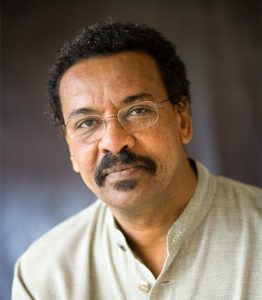
Salah M. Hassan. Photo: Jason Koski, Cornell University Photography (UREL)
Salah M. Hassan is the Goldwin Smith Professor of African and African Diaspora Art History and Visual Culture in the Department of Africana Studies and Research Center, as well as in the Department of History of Art and Visual Studies, and also serves as Director of the Institute for Comparative Modernities at Cornell University, Ithaca, USA. Hassan is also the Director of The Africa Institute, Sharjah, UAE. Hassan served as Professor of History of Art in African and African American Studies and Fine Art at Brandeis University, where he previously awarded the Madeleine Haas Russell Professorship in the Departments of African and Afro-American Studies and Fine Arts (2016-2017).
Hassan is a founding-editor of Nka: Journal of Contemporary African Art (Duke University Press). He currently serves as a member of the editorial advisory board of Atlantica, Journal of Curatorial Studies, and international Journal of Middle Eastern Studies, and served as consulting editor for African Arts. Hassan has contributed numerous essays to journals, anthologies, and exhibition catalogues of contemporary art, and has guest edited a special issue of SAQ: South Atlantic Quarterly, entitled African Modernism (2010). He has authored, edited, and co-edited several books, including Ibrahim El Salahi: A Visionary Modernist (2013); Darfur and the Crisis of Governance: A Critical Reader (2009); Diaspora, Memory, Place (2008); Unpacking Europe (2001); Authentic/Ex-Centric (2001; Gendered Visions: The Art of Contemporary Africana Women Artists (1997); and Art and Islamic Literacy among the Hausa of Northern Nigeria (1992), among others. Most recently, Hassan edited and introduced Ibrahim El-Salahi: Prison Notebook (MoMA and Sharjah Art Foundation Publications, 2018), and the forthcoming Ahmed Morsi: A Dialogic Imagination (Sharjah Art Foundation, 2020).
Hassan has curated a number of international exhibitions in museums and at major Biennales such as Venice and Dak’Art, including Authentic/Ex-Centric (49th Venice Biennale, 2001), Unpacking Europe (Rotterdam, 2001-02), and 3×3: Three Artists/Three: David Hammons, Maria Magdalena Campos-Pons, Pamela Z (Dak’Art, 2004), among others. He curated Ibrahim El Salahi: A Visionary Modernist was published in 2012 held at The Tate Modern in London (2013) after premiering at the Sharjah Art Museum in Sharjah, UAE (2013). In addition, he also co-curated The Khartoum School: The Making of the Modern Art Movement in Sudan, 1945-2016 (2016-2017) and When Art Becomes Liberty: The Egyptian Surrealists (1938–1965) (2016) funded by the Sharjah Art Foundation.
He is the recipient of fellowships including the J. Paul Getty Postdoctoral Fellowship as well as major grants from Sharjah Art Foundation, Ford Foundation, Rockefeller Foundation, Afrique en Créations, Andy Warhol Foundation for the Visual Arts, and the Prince Claus Fund.
This session will highlight his career and provide an opportunity for dialogue between and among colleagues. The panel will include Dr. Hassan as well as the following: Chika Okeke-Agulu (Princeton University); Elizabeth Giorgis (University of Addis Ababa); and Iftikhar Dadi (Cornell University).
The live online Q&A will be held Thursday, February 11, 2021, 10:30-11:15 am EST.
International News: Letters from the Asia Art Archive UnderLockdown (Part II)
posted by Allison Walters — November 17, 2020
This is Part II of an article that began last week in CAA News. It continues the coverage of life and work at the Asia Art Archive during the COVID-19 pandemic.
Mutual Aid, Cici Wu, Research Assistant, Asia Art Archive, New York
New York declared a state of emergency on March 7, 2020. I couldn’t foresee then that this would be my last chance to be in an art museum for many months. I was looking at the Portrait of America by Diego Rivera in the Whitney Museum, which he painted in 1933 for the Communist New Workers School in New York. The text panel said, “In keeping with the politics of the school, Rivera chose not to celebrate American values but instead to highlight uncomfortable truths about the class struggle and the country’s violence against African Americans.” In 1929, the crash of the US stock market caused many to question a capitalist system that seemed no longer compatible with the country’s democratic ideals. Artists resolved to use their art to effect change. Looking back at this period in history, when Mexican muralists were invited to make artworks by the State, it’s striking how artists were allowed to use their creativity and imagination so freely. They also imbued their art with a social role by depicting the real struggle of workers. It was uplifting.
A month before March 7, a memorial gathering for the Chinese doctor Li Wenliang was quietly held in Central Park (Fig. 1). The event was organized to stand against the further erosion of free speech in Mainland China. The park was not crowded. People were dispersed into smaller groups on a sunny afternoon, with murmurs, sighs, and tears. The flowers and banners carried words from the bottom of people’s hearts. At that moment, there was a hope that a little change could happen this time.
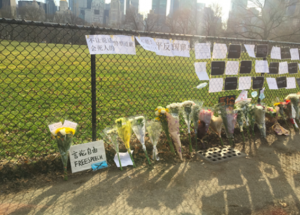
Figure 1. Memorial for Li Wenliang, Sheep Meadow in Central Park, New York, February 9th, 2020. Photo provided by the author.
After March 7, events seemed to accelerate, further unveiling lies, alongside vulnerability, rage and confusion. A wound was suddenly ripped open, resulting in a flowing river of blood. Sad news stories kept coming, one after another, from Italy, Iran, the UK, the Philippines, and the rest of the world. Airlines were collapsing. Small businesses were at risk. Middle-class and working-class people started worrying about their future. All of a sudden, restaurant workers, airline employees, and gig workers were on the verge of being laid off. Immigrants and undocumented residents without families were most at risk. More than ever, we learned that our social welfare was deeply tied to our immigration status in this country. We wondered, how are we going to collectively survive other crises, such as the huge environmental shifts and resulting displacements, that will come in the future?
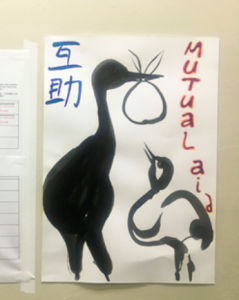
Figure 2. A mutual aid poster on display at 172 Henry Street in Chinatown, New York, April 25th, 2020. Photo provided by the author.
For a short time, New York became a site of discombobulation, isolation, and helplessness. The city was pale and empty. Workers in the arts, who were lucky enough to keep their jobs, started to work from home. Essential workers, including doctors, nurses, delivery drivers, and home caretakers, were getting off from work shattered. After a period of panic, some artists started to break out of their isolation and regather in small volunteer communities, helping food pantries, protesting against evictions, and organizing mask donations, all built upon the principle of Mutual Aid Community Agreements: “We Keep Us Safe” (Fig. 2).
The city began returning, bursting with idealistic energy. Most precious for the Asia Art Archive in America during this time has been the support and care we have been able to provide for each other. Invaluable weekly virtual meetings helped us stay connected and in dialogue, discussing together our changing thoughts throughout this critical time.
Our research collection, the Joan Lebold Cohen Archive Phase II was successfully launched online in the height of lockdown, on April 1. Three years after the launch of Phase I, the trips Joan Cohen took to China from the 1970s–2000s are finally fully available to explore and learn from: 16,453 color photographs of artists, artworks, studios, academies, exhibitions and scenes of everyday life. These images of a past world travelled through the years and arrived at a moment when nations are drifting apart towards isolation. In the midst of reimagining a new spatiotemporal organization of the world, the looks, smiles, and gestures Joan captured on film brought to mind air and light (Fig. 3).
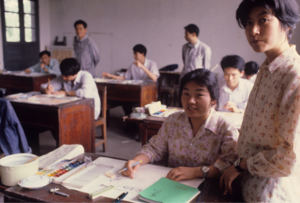
Figure 3. Students in art and design class at Guangzhou Art Academy, Guangzhou, China, 1980. Photo: Joan Lebold Cohen Archive, Asia Art Archive, NY
In Beijing and Hong Kong before returning to New York in February, I was saddened to have witnessed the virus hitting the collective body multiple times. Working through the Joan Lebold Cohen Archive was a healing process, to imagine myself traveling in time and giving light to the gaps of multiple pasts. I want to end here with a quote from the essay Solidarity/Susceptibility by Judith Butler (Social Text, 2018), from her remarks on José Muñoz, the Cuban American scholar of performance and queer studies who died in 2013, as an inspiration to think about archives and the new imaginary: “The potentialities that appear as rips and tears in the otherwise seamless future of no future for those abandoned by progress are immanent and furtive possibilities within the present, indicating that this time is also another time, and always has been; it opens toward a past and a future even when, politically, the force of oblivion seeks to cover over those very openings.”
Erasures and Experiments: The COVID-19 Story in India, Noopur Desai, Researcher, Asia Art Archive, India
Today, we are experiencing an unprecedented moment as we brave the COVID-19 crisis across the world. In India, the situation is complex, similar to many parts of the world, bearing multiple strands, with implications for various aspects of our lives. When the pandemic hit India in March of this year, though early cases were found in January, the country was going through a massive political movement demanding democratic constitutional rights. The announcement of a sudden lockdown across the country on March 22 resulted in the suspension of all social gatherings including, most importantly, the ongoing nationwide sit-in protests against the Citizenship Amendment Act and the National Register of Citizens in various cities and towns.
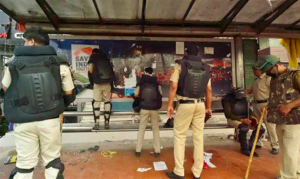
Figure 1. Graffiti and artworks at protest sites, removed by the police during the lockdown, “The Logical Indian,” March 27, 2020. Photo: Hindustan Times
In the midst of panic and uncertainty in conjunction with the mismanagement of the crisis, the previous two months began to appear a distant past with the erasure of politics and the transformation of public space during the lockdown. In effect, the public space was rather transformed, with images of a mass exodus as hundreds of thousands of migrant workers journeyed home from big cities after the closing down of markets, manufacturing units, and various laborer jobs. Combined with a sense of amnesia brought on by the spectacle surrounding the pandemic, the government actions (mis)used the situation to crackdown on dissenting voices, either by arresting social and political activists, defacing artworks and graffiti at protest sites (Fig. 1), or by exercising certain restrictions on media. Taken together these actions have highlighted the systemic inequality and repressive nature of the current regime.
Surrounded by this grave situation, various arts organizations, artists, and museums have had to reconfigure themselves. Several exhibitions and programs were canceled or postponed, and young arts practitioners moved back to their birthplaces or are struggling to survive in metropolitan centers like Delhi or Mumbai. Responding to the severity of the crisis, many arts practitioners and arts organizations have stepped up to create support systems, including grants for young artists, online displays of artworks, and the formation of chain-systems, wherein artists buy each other’s work. The arts community also created online auctions and other fundraising events to contribute to the relief work for migrant workers and other vulnerable populations.
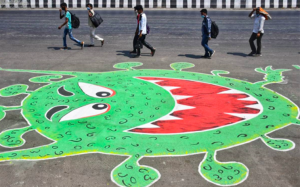
Figure 2. Migrant workers walk in front of a coronavirus graffiti in Mumbai, May 14, 2020. Photo: The Hindu
Physical distancing quickly resulted in digital proximity with the arrival of webinars and online exhibitions organized by museums and galleries, although the graph of the webinars seems to be “flattening” in recent times! However, the digital world has become an intrinsic part of our lives, whether it is through virtual studio visits, webinars, and simulated gallery tours or by creating online resources for teaching and learning. In terms of art education, studio-based practice has been replaced by experimentation with the digital, though only at a few schools, as most of them do not have the resources to run online programs. Nevertheless, there have been important instances where students have used digital platforms to organize their annual exhibitions, which are required for graduation, and which for the most part have not been able to take place physically. Though physical space is crucial in contemporary art practice, this intense effort to use alternative platforms has certainly paved the way for forming new aesthetic possibilities.
While we all are grappling with this strange time, at Asia Art Archive in India we continue building our online research collections and shaping new projects. As an online platform, we have been able to continue several aspects of our work by sharing digital resources and programming via our website. Despite this, we have also faced challenges in light of changing situations. Though our collections are available online, the groundwork to build those collections requires in-person visits to archives and libraries, access to review personal archives, resources to digitize the documents, and programs to introduce the archival collections; most of these activities have been brought to a halt for now. In the meantime, we are maintaining our spirits by planning and carrying out whatever aspects of our work we can, keeping in mind the need for physical distancing. At the same we are recalibrating our working methods as we venture into the “new normal.”
CWA Picks for November 2020
posted by Allison Walters — November 13, 2020
November CWA Picks
November Picks from the Committee on Women in the Arts celebrate an array of exhibitions and public artworks featuring feminist and womxn artists in this transitional time. As always, our global highlights are informed by shows and events that explore social justice issues and intersectional feminism.
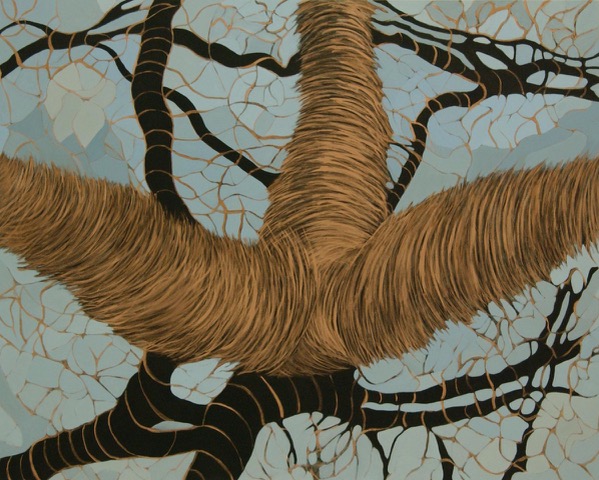
© Eunice Golden 2006
“Metamorphosis #17” Acrylic on Canvas
48″ x 60″
- The Shape Of Play: Sari Carel’s recent public art installation at Waterfront Park in Boston pushes the boundaries of modern art, sound art, childhood and play through this heavily researched and process oriented, interactive work. For more information on the piece, you can also visit here and here.
- Eunice Golden: Metamorphosis: SAPAR Contemporary presents the gallery’s first exhibition devoted to renowned artist and radical feminist Eunice Golden’s (b. 1927, Brooklyn) late paintings and prints, and an opportunity to celebrate her enduring contributions to feminism and activism since the earliest years of the feminist art movement. The exhibition features her recent large-scale series, Metamorphosis (2003-2007) and Flora (2009), evoking her early sexual bodyscapes and exploring through gestural expanse of color, rapid brushwork, and hypnotic patterning, contemporary issues around ecological uncertainties and challenges. Through Nov. 28, 2020.
- Feminist perspectives in artistic productions and art theories: The Artium Museum 2-day course directed by Directed by Xabier Arakistain, art curator, and Lourdes Méndez, professor of anthropology of art at the UPV / EHU, includes a variety of speakers around contributions of feminist artists and theorists of art and the theoretical and political problems that must be faced today in order to continue developing and disseminating art and knowledge free from androcentric and ethnocentric biases. Nov. 14-15, 2020.
- Jo Ractliffe: DRIVES: Chicago Art Institute presents the first survey of South African photographer Jo Ractliffe (b. 1961), featuring more than 100 large scale color prints, video and documentary photographs spanning her career, including dreamlike photographs made in the 1990s of the port city of Durban and on a cross-country road trip, the unsettling installation N1 Incident/End of Time(1997/99), and much more. Through April 26, 2021.
- Baltimore Museum of Art presents several current exhibitions centered on women artists and ideas. Perfect Power: Motherhood and African Art includes 40 representing the power of African mothers and maternal imagery, through Jan. 17, 2021. Candice Breitz: Too Long, Didn’t Read features two muiltichannel video installations by the South-African born artist on privilege, visibility and the fetishizing of celebrity, through Jan. 10, 2021. Shinique Smith: Grace Stands Beside, is a new deity-like figurative sculpture by the artist who was raised in Baltimore, using Baltimore resident’s donated fabric to exude, said the artist “a complex state of being that Black people and other who have endured tragic prejudice have embodied to survive and rise beyond,” through Jan. 3, 2021. SHAN Wallace: 410 is an immersive collaged environment installation by the Baltimore based artist SHAN Wallace, through Jan. 3, 2021. Other notable exhibits include: Katharina Grosse: Is It You?, Valerie Maynard: Lost and Found; Ana Mendieta: Blood Inside Outside; Howardena Pindell: Free, White and 21; Jo Small: Flying with Remnant Wings; Elissa Blount Moorhead and Bradford Young: Back and Song; all through Jan. 3, 2021.




